Somehow the bag got flipped over.
2 cameras headed straight down onto the road. The one would survive with a mere scuff but the hit snapped the door clip off on my Canon EOS 300X (aka Rebel T2/Kiss 7).
I had killed the last Film SLR designed by Canon.
But I’m torn if I’m gonna replace it or just move on. It’s 5 part technical brilliance mixed with dollop of marmite.
I’m to blame I’d overloaded with the 300X and a NONS SL42 in a tiny bag. But when I flipped the clip open I hadn’t realise the bag was upside down. Both cameras head down onto tarmac.
The NONS surprisingly survived but not the 300X.
This was the last film camera launched by Canon. It would disappear along with all other Prosumer and consumer EOS film cameras in 2007. Only the the professional EOS 1V soldiered on until 2018.

In 2000 Canon were sitting pretty versus its great rival Nikon at all but the pro and prosumer end (and even there it was a bit of a dog fight).
The mid range Nikon remained erm… the F70. A technically brilliant camera at launch in the early 90’s. But it had one of the worst user interface in camera history. And by the 2000’s a single AF point 5 zone meter was feeling creaky. The EOS 500 Series broadly out did this perhaps bar build and shutter speed
But the winds of change were coming at Nikon. And Minolta and Pentax were not letting them rest either.
The EOS 300 begins
Canon didn’t really need to try that hard when they launched the original EOS 300 (aka Rebel 2000 & Kiss III) in 1999. So on one level it is an evolution of the EOS 500n, a fine mid range camera for the late 90’s camera. But Canon pushed the boundaries. I guess Minolta and Pentax were giving them something to think about and it’s likely they knew Nikon wasn’t sitting still.
You’d struggle to see the difference on the outside with only the inclusion of a DoF preview button being the stand out difference.
But underneath you got a camera that featured much of the capacity of the more expensive EOS 30 (ELAN 7). So the camera like all the rest in the series features not just a DoF preview button but 7 AF point focus system combined with a 35 zone matrix metering. The EOS 300 was an award winner and massive commercial success for Canon.
But 2 cameras would change the course of the series one digital and one Nikon
Deux Ex Machina – EOS 300V (2002-2004)
In 2002 the camera was replaced by the EOS 300V (Rebel Ti/Kiss 5/All New Kiss). On one level this is just simple revisioning. Canon bring in a metal lens mount and make the AF faster. Minor but logical stuff. But another EOS 300 camera’s development would have a much bigger change.

This work is licensed under a Creative Commons Attribution-NonCommercial 2.0 Generic License. Click on image for full sized version on Flickr
Although launching the following year, the Canon EOS 300D dSLR’s fingerprints are all over the 300V. You get that same big rear LCD panel although the dSLR uses that for as much image review.
Both cameras dump the top plate LCD (the 300D actually has a split rear LCD). The influence across both is obvious and what’s clear if it wasn’t joint development then at least the 300V influenced the 300D design. Whilst the missing top plate LCD makes some sense in one of the first consumer dSLR to come under the $1000 USD mark, I’m not sure about the film body. The 300V also has a slightly odd circle of controls on the top plate where the mode dial was moved from.
But Canon would replace it in 2004 with our subject for today.
Enter The Nikon F75 & the birth of the 300X
It’s likely what cycled the replacement was the last gen of Nikon Film SLRs. Canon had clearly put Nikon on the back foot through the 1990’s and despite the F90 and F5 fight back at the prosumer and pro end things were somewhat pants down in the consumer end. You had the F70 (great spec shame about the interface) and the F-401x (better interface but using 1980’s tech) being the main opposition.
Into the 2000’s the camera smartened up but the F40 & F60 were essentially the F-40X in new clothes. The F65 did fire a warning shot of what was to come and along with the Legendary F80 showed what a 21st century Nikon could achieve. But the EOS 300V was still up against the F70.
Until 2003 and the Nikon F75.
And this is where Nikon get their s#it together. I’m on record as arguing this one of nikon’s finest Consumer bodies. It has a logical interface and you can shoot most Nikon AF lenses of the the time with no question and you can even mount and use manual focus AI glass with rangefinder support.
And the cynic in me thinks this is why the 300X arrived.
EOS 300X Build
So yes as you’d expect this is a lightweight plastic body camera. It’s well enough made with a metal plate mount plate. And the whole thing did not disintegrate when I dropped it 1 m (there’s hardly a scuff on it). But the catch blew. This is interesting as I was well aware of the door clip issue on the later prosumer and consumer Nikons but not Canon. That said I suspect a EOS 3 or EOS 1V would probably have survived unscathed (and likely dented the tarmac). But the are pro built nad much heavier.
It’s a compact little mite about 1 cm narrower than the EOS 300.
There is a metal mount plate that was introduced in the 300V. A week point is the battery compartment cover which feels a little flimsy. And the catch on the door is hardened palstic not metal as I discovered.
The camera sadly seem only available in that silver finish that seemed to be fashionable in the late 90’s and early 00’s. Bit like lace up jeans then
It looks very much like a dSLR and any of of a number of rival products and I can’t say the F75 is better made (it is at least available in black). But the LCD like the EOS 300V is on the rear.

EOS 300X – Under the Hood
The whole 300 series basically gave you the same functional capabilities as many of the the more prosumer models in a lighter build. The 300X is no exception
Autofocus
As stated earlier you have a 7 AF point system here which you can select individual points (in PSAM modes only). It is pretty slinky and is a step up from the EOS 1000F I own and perhaps a bit faster than my EOS 500N.
I’m not sure it out focuses my F75 that much either.
It uses a CMOS based TTL-CT-STR (TTL Cross Type secondary image registration) sensor. Cross type sensors tend to be more accurate as they use two sensors to give a better 2D positioning.
The camera has a DoF preview like the other 300 series models.

Exposure
Nikon had still had the edge with their metering systems but this camera comes out blazing with a 35 zone matrix meter. Sound great on paper but the difference between this and F75’s 25 zone is marginal. The 300X does offer partial (aka spot) and centre weighted metering but the latter only in manual. Meanwhile the F75 lets you custom set these in a mode.
Where the 300X does standout is with shutter speed with a 1/4000 top speed. That’s a stop faster than the F75. The camera offers speeds in /12 stop increments down to 30 sec . You can also set to bulb and using a Canon proprietary cable you can triggers this off camera with a second delay.
The rival from Sendai can’t match the top speed but does offer stepless shutter down to 30sec and a IR remote.
The camera offers auto DX coding (25-5000ISO) but you can manual override this to set between 6-6400ISO. EV compensation can be set up to ±3EV in ½ stops.
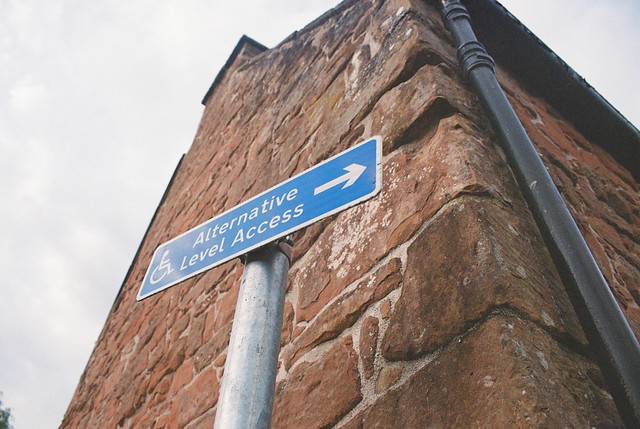
Viewfinder
The diopter adjustable viewfinder is good although like the F75 it is a pentamirror showing some budget cutting. This means it’s a little darker than same era pentaprism finders but it is still reasonably bright. The in-finder information is exactly what you need. Below the 90% coverage focusing screen is a LCD strip that shows focus lock, shutter,aperture and EV comp (this doubles as the manual exposure bar). There is also flash info and AEL (Auto exposure Lock)
Focus points are shown with squares that have a light up red LED dot in middle to show focusing. It’s effective but I prefer the Nikon F75 screen. This is an AF only screen and you can’t swap it.
Flash, Drive and power
The built in TTL flash (E-TTL II type) offers a reasonable 13GN100ISO/m with a 1/125 sync speed. This a Type A E-TTL II camera. So with the right speedlight you can get high speed shutter sync. This allows you to shoot much faster – not to motion freeze per se. But very helpful if using fill in flash for very bright backlit areas.
2 CR2 power this but there doesn’t appear to be an additional battery pack unlike the earlier EOS 300 (that won’t fit as the battery compartment is different.
LCD & Controls
On a plus most of the common buttons are in the typical Canon place with a command dial vertical behind the shutter button and AEL and focus select at thumb level on the rear. a drive/self timer button is on the top plate.
But the mode dial has moved to the shutter side. I think Canon were aiming to make this more one handed as it can be turned from the rear side like a command dial. The LCD has moved to the rear.
On a plus it’s a big LCD but I found it a bit meh. I much prefer a LCD on top plate. I found it weird Canon ditched a perfectly good layout for this. At least it hasn’t got the weird controls on the top plate like the 300V that also has a rear LCD. It’s a marmite thing – I just don’t like it. but it isnt the nightmare that the F70 was and it is still better than second Gen AF Nikons like the F601 & F-801.
Modes and Options
So the Mode dial has the usual Canon ‘creative’ modes – program (P, more controllable auto), shutter priority (Tv), aperture priority (Av) & Manual (M). The creative modes alos include A-DEP , which is a Canon stalwart and lets the camer judge optimal depth of field by identifying a near and far target and sets focus and exposure to optimise depth of field to You also get the so called basic or preset modes for ▭ (aka auto for everythings), portrait, landscape, macro, sports and night portrait The Basic modes also has a flash off mode as it is otherwise pops up in all modes if needed bar sports and landscape. In Creative modes you need to manually trigger it.
The rear LCD gives access to other features so you can set ISO, EV compensation and Auto Exposure Bracketing (AEB). You can also turn off the bleep from menu selection and set the camera to secure lock so wit won’t fire if unloaded or if missing a lens. there are also 6 custom settings which are kinda focused around focal points and flash settings and not a patch on F75 dedicated Custom modes.
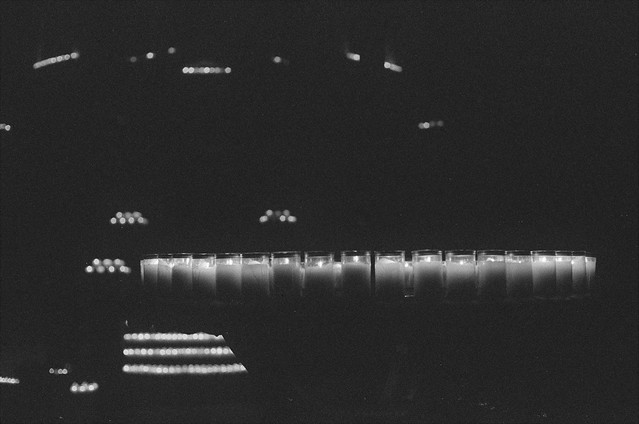
Lenses
This has a standard Canon EF mount so can use any EF lens (but not EF-M or R lenses) This gives it a coverage of any EF lens from the late 80’s to the ones canon make today.
3rd party support for newer lenses may be better although buyer beware. This one of only 2 EOS bodies I’ve owned that work with the Yongnuo YN 50mm 1.8 (the other being the EOS 3000V). Although basically a copy of the original Canon 50/1.8, Yongnuo skimped on the lectrics and it just doesn’t work with older film Canons including the EOS 500N and even the EOS 300. That said older film era lenses should be fine.
You can use non EF lenses using adaptors and the EF mount is arguably the best for doing so. The camera does meter in stop down fashion (stick it into Tv Mode) but there is no focus assist unlike the Nikon which offers rangefinder assist when using Nikon AI manual focus lenses (but no metering). That’s worth noting as the screen on both are not geared to manual focus lenses so the Nikon wins out here
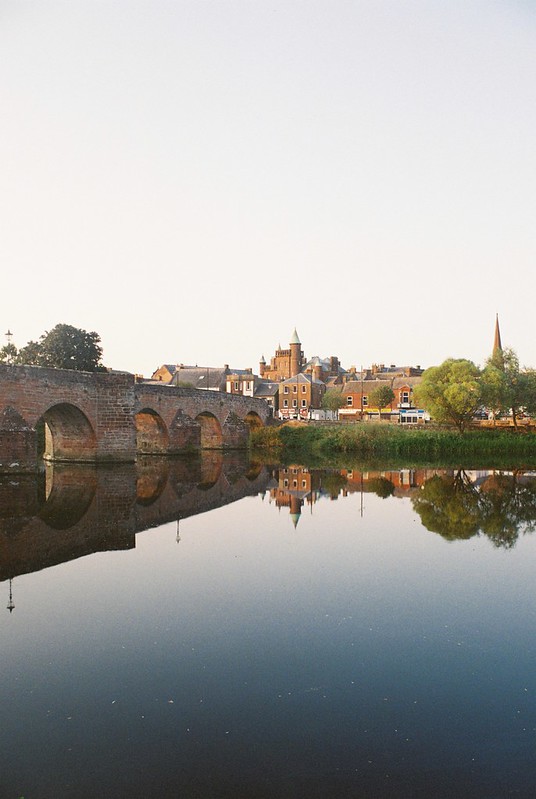
The EOS 300X In use
Okay I don’t like the interface but stick this into AV and I’m happy enough checking settings in the viewfinder. AF lock is fast and smooth. the camera holds well and although the LCD control system grates with me it’s a hell of a lot better than the Nikon F70 and even the more traditional push button LCD of the F90 and F-601.
The camera is lightweight and easy to hold with a low weight lens on. You can easily shoot one handed (not that I’d recommend that with any SLR)
Results
This is a good a camera in terms of performance and I can’t fault it. I even pushed it to very low light shooting before its death and the it diddo well enough although struggled to lock at times in lower light (but better than the F75)
It’s metering is accurate and focus quick and sharp.
But why move the display. granted some of you will be happy but to be frank this isn’t for me.
I had planned to shoot a lot more before publishing this review (and the P3200 had issues at the lab) so apols for the photos

Cost & Issues
I paid £65 for a pretty minty one (until i dropped it) this with the 28-90mm III lens. That’s a good deal and at the lower end of what you’d expect over the last 12 months. It cost around £40-50 for body alone
As usual the hand grip can be tacky (many seller make a point of this). This is easily rectified with wiping off gently with some isopropyl alcohol (if your stuck that’s what makes up most antiseptic hand gels but there tends to be residues).
Theoretically sticky shutter can be an issue due to foam degradation but this camera is so new it’s unlikely. But I’d still
Final Thoughts on the EOS 300X
Yeah. not gonna be trading in my F75 yet.
This a technically brilliant camera. Lightweight bonkers faster shutter for a mid range with good multipoint AF. It features similar core spec to the last film Elan but lacks it’s eye control and build quality. It overall technically outsmarts the Nikon F75 but not hugely. If you are a canon EOS shooter this is a logical camera to have but you might prefer the original EOS 300
And for me the Nikon is a easier mistress. It’s ironic – Nikon screwed up the technically brilliant F70 with the interface back 1994. And Canon weirdly do the same here (although to a lot lesser extent). I picked up the a EOS 300 which suits me better for just being a tad slower. But I guess this is more personal preference and the 300X is still way easier to use than the F70.
This is the marmite EOS. You’ll either love it or not.
Alternatives to The EOS 300X
We’ve obviously weighed up this camera against the Nikon F75 a lot here. But I’d argue wider choice comes from Canon’s own stable. The EOS 3000V (Kiss Lite/ Rebel K2) was the entry level model and is cheap to buy but basically has the same core spec of 7 AF/ 35 metering zones in a lighter and less durable shell. You trade a slower shutter of 1/2000 and lose the DoF preview but it’s way easier and cheaper to source
The jump to the EOS 30 (Elan 7E/ EOS7) series is not huge cost wise and offers the same spec in a more robust body plus eye control and a normal layout. The later revised EOS 30V (Elan 7NE/EOS 7s) from 2004 are just that bit ore expensive. These models can also be seen sans eye control as the EOS 33 (Elan 7) and the EOS 33V (Elan 7N).
The older prosumer EOS 5 has more robust build (bar the mode dial which can get dodgy) and again can be got for the same money
Other Sources & Resources
For the manual Canon USA still have links (Rebel T2) but at some point I suspect this will disappear but Butkus has it listed (just drop Mike a wee donation). Canon lists the camera in their camera museum.
There is a positive & useful review on 35mmc but oddy there aren’t many other views out there other than plages regurging the tech spec.

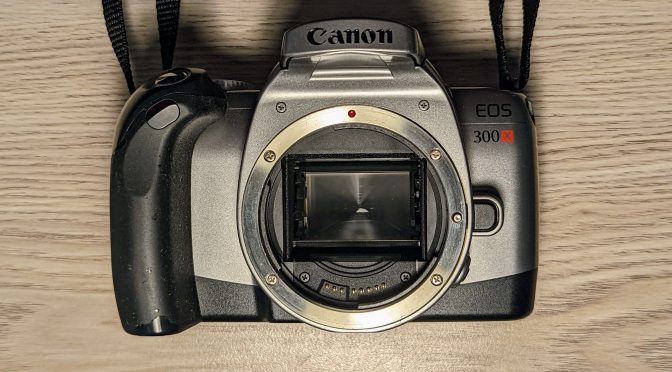
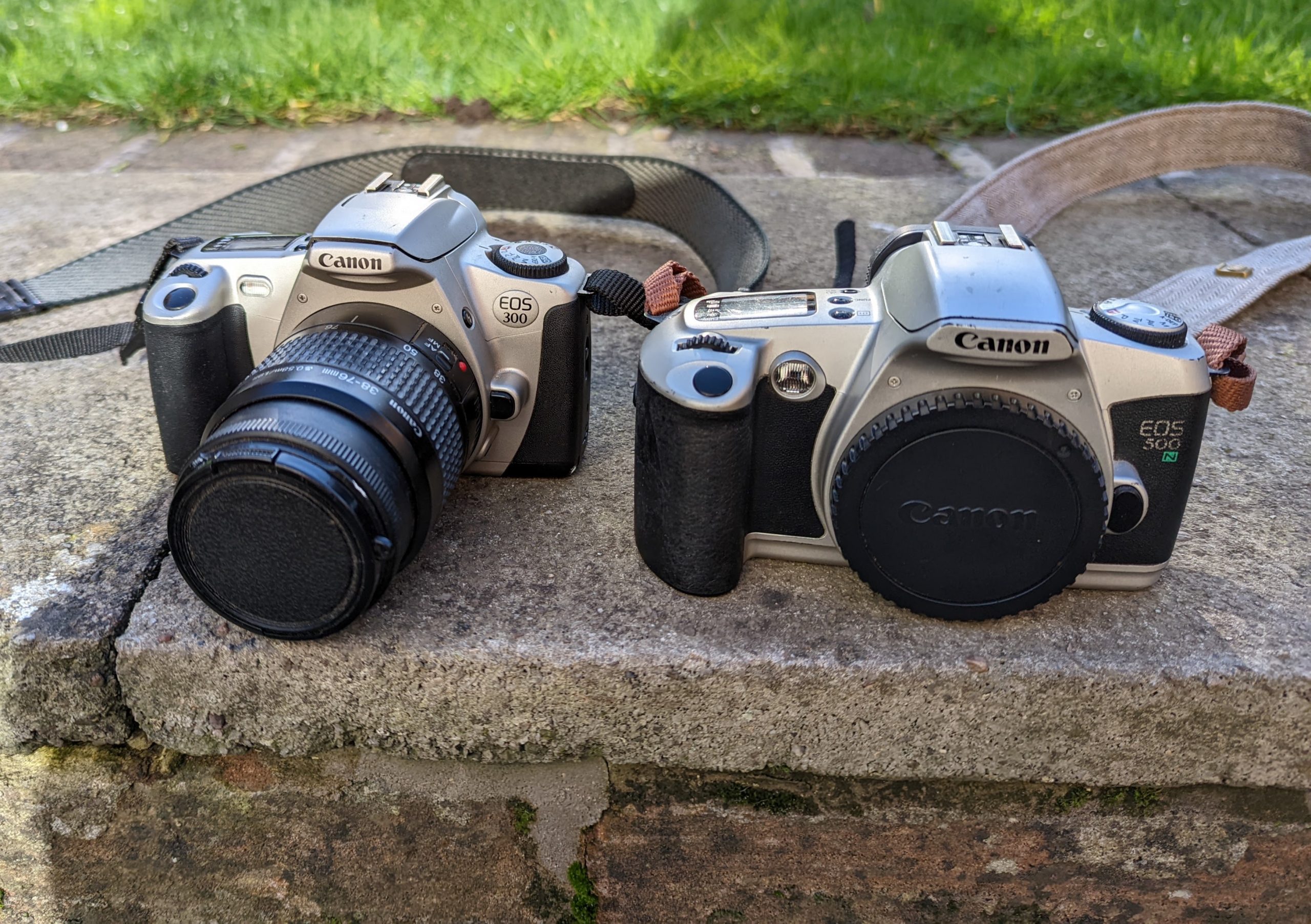
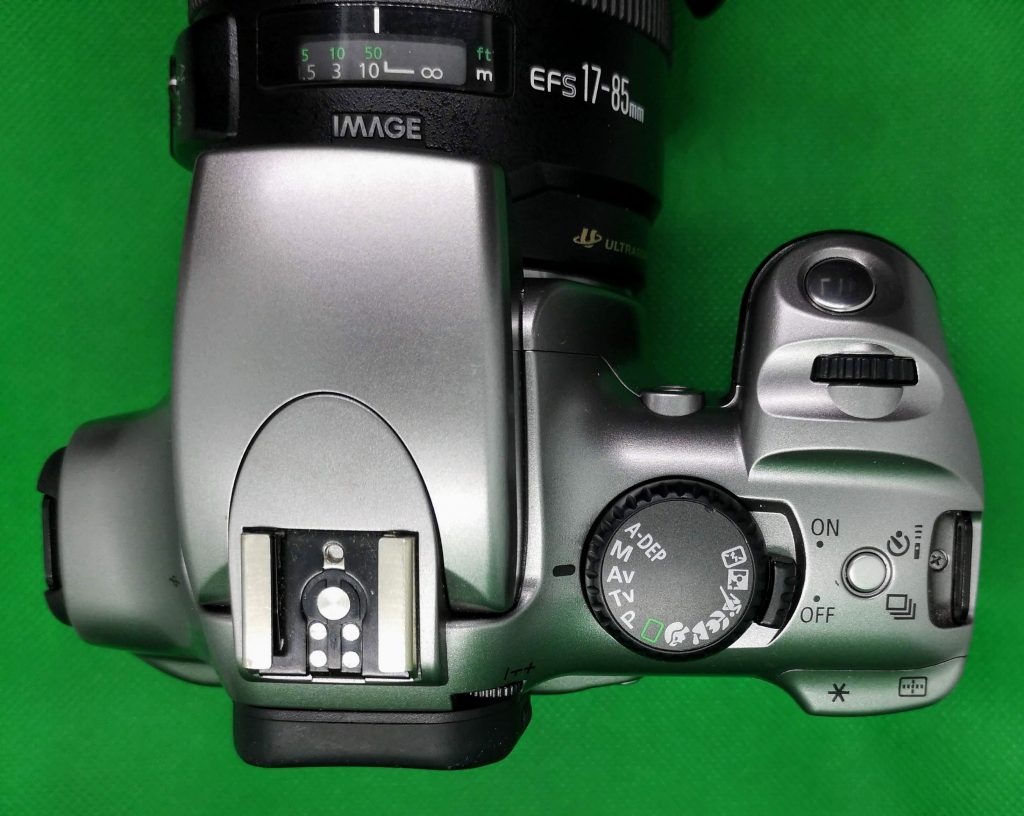
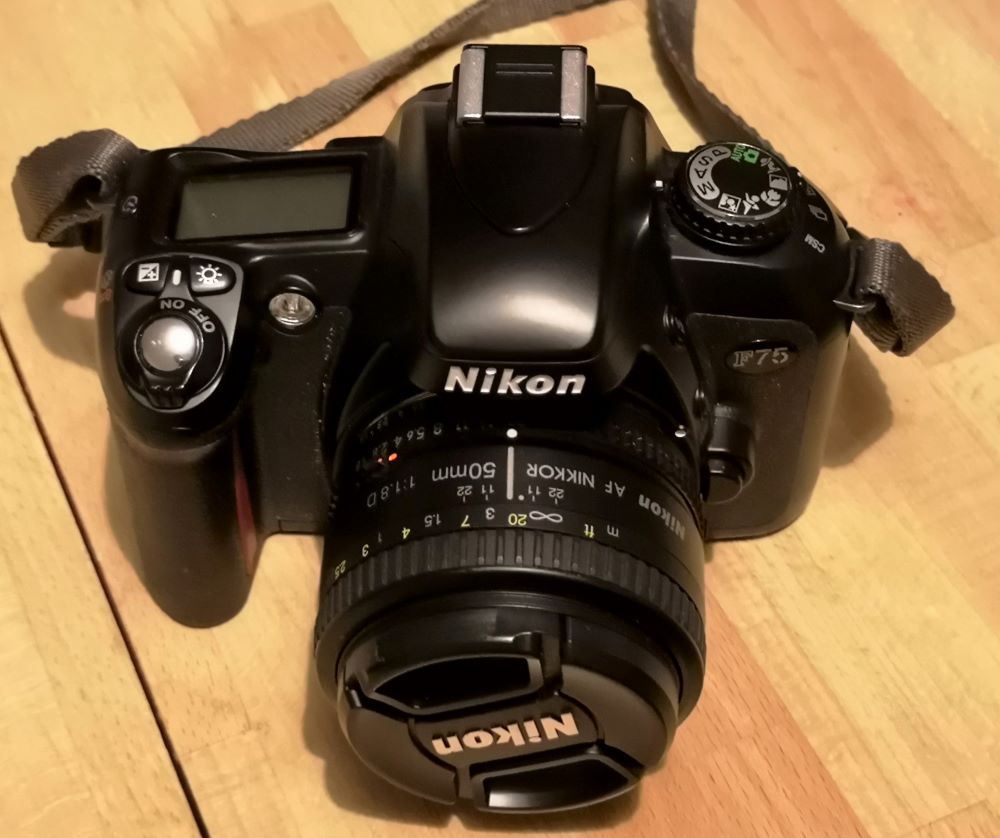
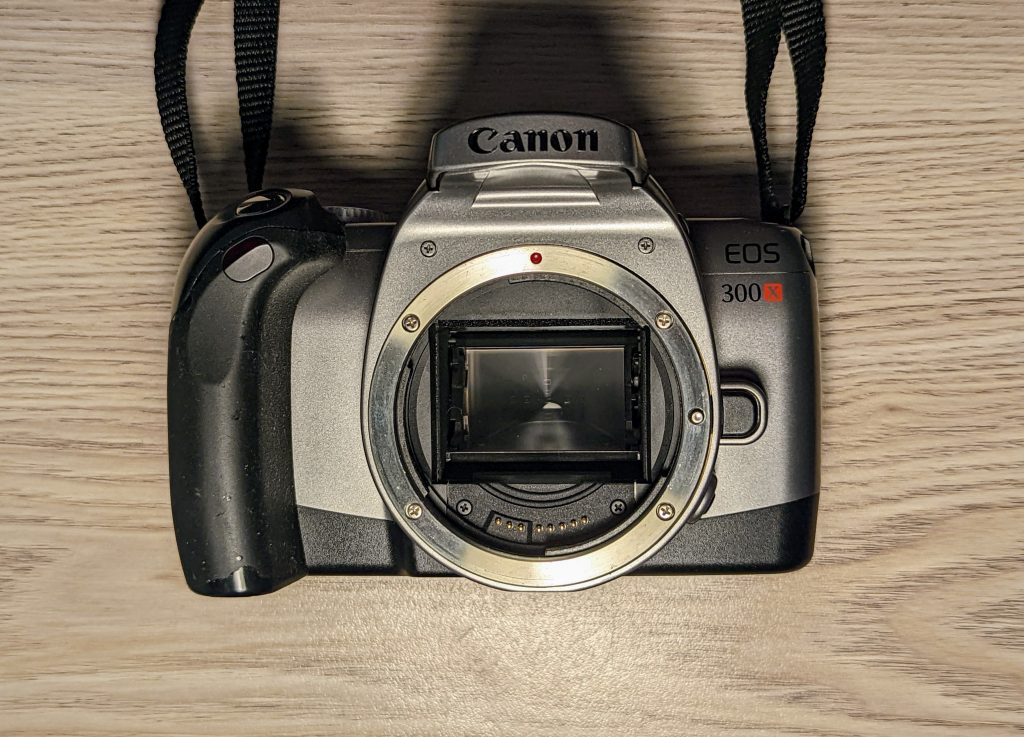
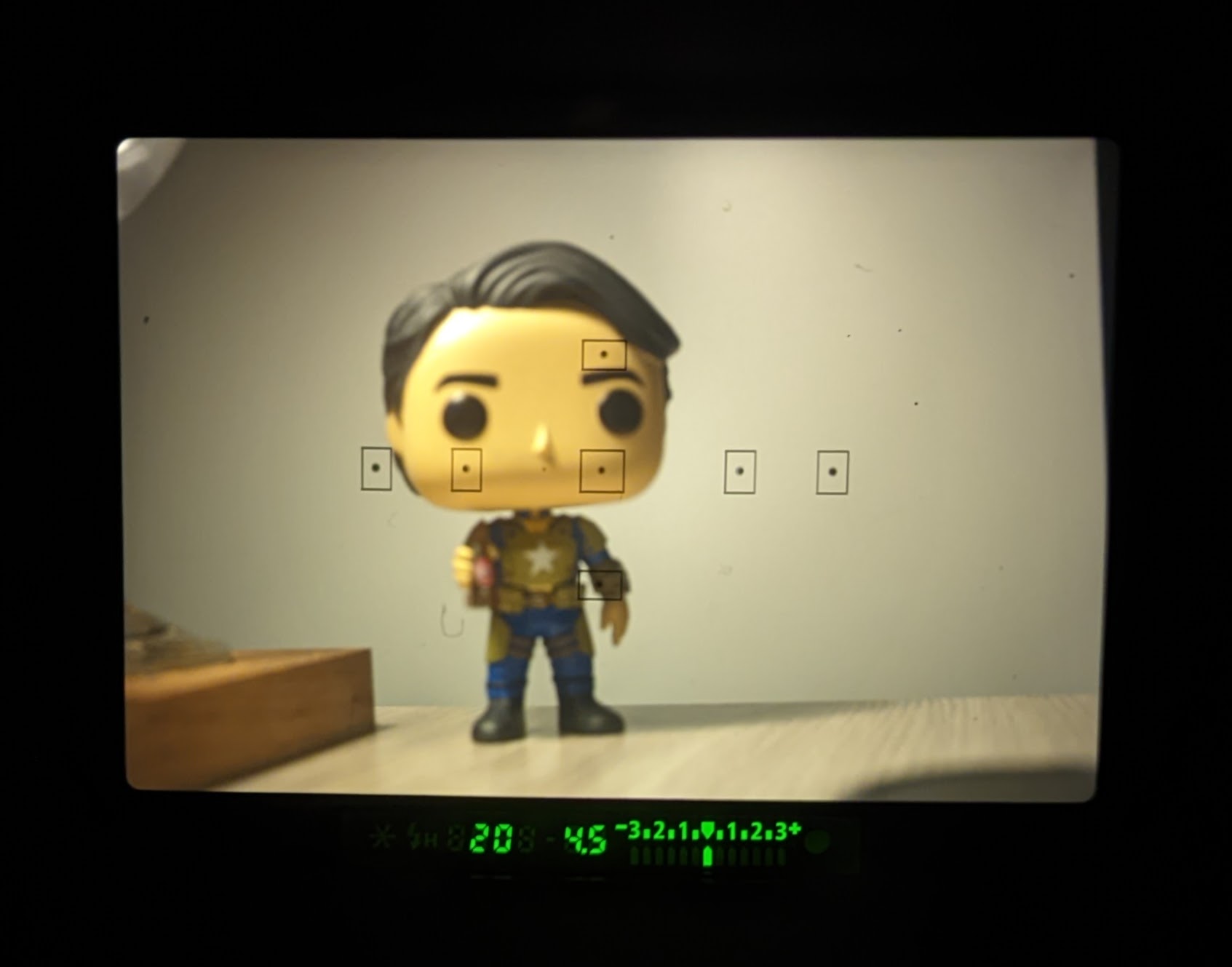


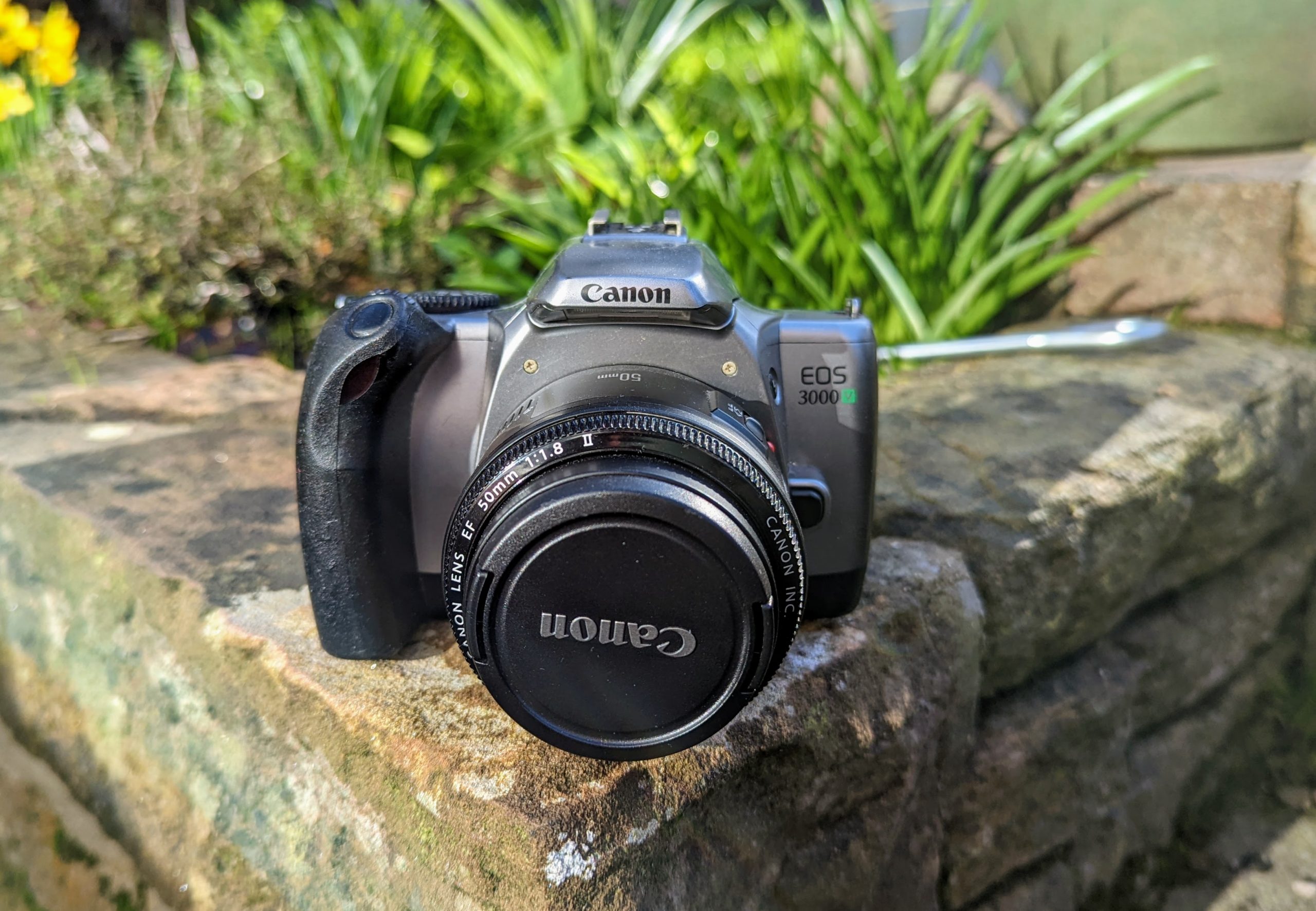
Can’t you fashion some kind of geegaw with sticky velcro tape to keep that back door jammed shut when it’s loaded?
I own both, but the one thing you didn’t mention is the viewfinder magnification of the Nikon F75 is even smaller than the Canon – 0.68x vs 0.70x, 89% coverage vs 90% coverage.
I actually find this very unpleasant/uncomfortable to even frame shots on. I don’t know what it is about that 0.02 less, but it does make a difference.
Thank you for taking up on my suggestion to review this and the 3000v. I just wanted to share my experience that they are cheap and do everything you need them to do. Also , as Ken Rockwell said, never underestimate the value of a light wight camera. My Eos 5 stays at home, it is too heavy and just no fun carrying around. These cameras are a light weight unincumbered joy.
Sorry I meant Eos 3 not 5 , my point is the pro cameras are too heavy to be any fun. Also I can happily give a 3000 or a 300 to another person to take a picture with and not worry about them dropping it
Oh no, I’m a comments bro!
Quick note that there is a grip for this camera. It’s the BP-220, which takes AA’s and has a vertical shutter button. It’s a fit with the 3000v body too, so useful if you don’t have time to change films but still want the vertical grip and to use cheaper batteries.
That I did not know and Canon didn’t make it obvious. Cheers for mentioning this. They seem v.rare in the wild
Quick search looks like they fit the 300v too. You’d have thought there would be more of them!